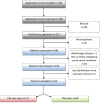Complementary medicine use during cancer treatment and potential herb-drug interactions from a cross-sectional study in an academic centre
- PMID: 30911084
- PMCID: PMC6434040
- DOI: 10.1038/s41598-019-41532-3
Complementary medicine use during cancer treatment and potential herb-drug interactions from a cross-sectional study in an academic centre
Abstract
Complementary medicine (CM) is used by one third to one half of cancer patients throughout the world. The objective of this study was to describe the prevalence of CM use and the potential for interactions with cancer treatments in an academic oncology centre. A cross-sectional study was conducted among patients undergoing current cancer treatment. Among 132 included patients, 56% had used CM since their cancer diagnosis and 45% were using CM during cancer treatment at the time of the survey. The main CM used were green tea (35%), herbal tea (35%), homeopathy (27%), dietary supplements (27%), and herbal medicines (27%). A small majority of patients (58%) spontaneously mentioned the use of CM to their oncologist. Of 42 identified combinations of concomitant use of biologically based CM and anticancer agents among the study patients, the potential for pharmacokinetic interactions of clinical relevance was not expected in 17 combinations (40%), hypothetical and deemed unlikely in 23 (55%), and of probable low clinical relevance in 2 (5%). Considering the high prevalence of CM use, active enquiries should be made by healthcare professionals to detect symptoms that may relate to CM tolerance and effects or that suggest interactions between CM and cancer treatments.
Conflict of interest statement
The authors declare no competing interests.
Figures




References
-
- Eisenberg, D. M. et al. Trends in alternative medicine use in the United States, 1990–1997: results of a follow-up national survey. Jama280, 1569–1575 (1998). - PubMed
-
- Eardley, S. et al. A systematic literature review of complementary and alternative medicine prevalence in EU. Forschende Komplementarmedizin (2006)19(Suppl 2), 18–28, 10.1159/000342708 (2012). - PubMed
-
- Molassiotis, A. et al. Use of complementary and alternative medicine in cancer patients: a European survey. Annals of oncology: official journal of the European Society for Medical Oncology16, 655–663, 10.1093/annonc/mdi110 (2005). - PubMed
MeSH terms
Substances
LinkOut - more resources
Full Text Sources
Medical

